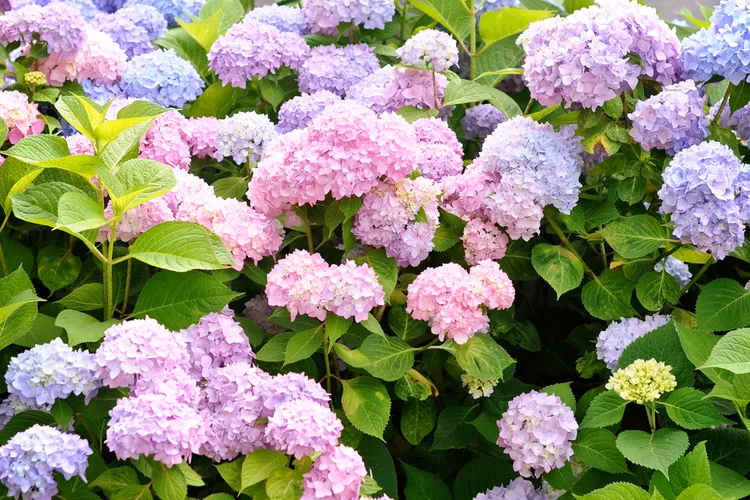Fans of hydrangeas admire their big, beautiful blooms. Chances are the neighborhood deer do, too. The tender flowers of hydrangeas are usually the first parts of the plant the deer devour. This guide includes several effective strategies from garden experts for keeping the hydrangeas you’ve carefully planted and tended intact and away from the mouths of deer.
- Lorraine Ballato is an expert horticulturist and author of Success with Hydrangeas: A Gardener’s Guide.
- Ryan McEnaney is the marketing and communications manager for Bailey Nurseries and author of Field Guide to Outside Style: Design and Plant Your Perfect Outdoor Space.
Do Deer Eat Hydrangeas?
Though some types of hydrangeas have certain attributes that are less appealing to deer, these shrubs are not considered deer-resistant plants. “Deer like all hydrangeas, so even if your hydrangeas have not yet been nibbled, that doesn’t mean it won’t happen," says Lorraine Ballato, author of Success with Hydrangeas: A Gardener’s Guide. "The level of deer damage can change from season to season and depends on the size of the deer herd, available forage, competition for food, and changes in deer habitat,” says Ballato.
Identify deer damage by looking at the remains of browsed plants. Because deer don’t have upper incisors, they feed by tearing vegetation with their lower teeth and upper palate. That often leaves jagged stems behind.
Tips for Protecting Hydrangeas from Deer
You’re not alone if you find yourself constantly trying to keep deer away from your hydrangeas. Implement some of the following strategies to minimize deer damage.
1. Use deer-repelling plants as a barrier.
No plant is completely deer-proof. However, some plants are lower down on the deer menu, including those with prickly spines, leathery leaves, or milky sap. Garden designer and author Ryan McEnaney suggests using such plants to “create distance between your hydrangeas and the deer.”
2. Arrange scented plants around hydrangeas.
Plants with strong scents are usually a deer’s lowest priority to eat. Surrounding your hydrangeas with fragrant plants makes the area less inviting to the animals, encouraging them to go elsewhere. “Try creating a border in front of your hydrangeas with fragrant plants such as salvia, lavender, peonies, sage, or any plant in the mint family,” says McEnaney.
3. Plant hydrangeas close to your home.
Most deer are shy creatures, preferring to stay away from open spaces, buildings, or areas with a lot of human or pet activity (there are definitely exceptions to this rule though!). Keeping your hydrangeas as close to your house as possible makes the shrubs a less appealing target. And definitely plant hydrangeas as far as possible from wooded areas to help reduce deer damage.
4. Select woody types of hydrangeas.
McEnaney says that when it comes to outsmarting deer, it’s best to plant hydrangeas with woody stems. That's because deer tend to go for tender stems rather than woody, tough ones. “Panicle hydrangea, oakleaf hydrangea, and bigleaf hydrangea bloom on last year’s woody stems and therefore are less likely to be browsed by deer than smooth hydrangeas that bloom on new wood and are ultimately more palatable for deer.”
5. Install an electric fence or an 8-foot deer fence.
A deer-proof fence is the best option for completely keeping the animals out of your garden long term, but is also the most costly solution. And having a tall fence around your property may be an eyesore in your landscaping plan, but you can make it less noticeable by placing where it can blend in with surrounding shrubs and other vegetation.
6. Surround the hydrangeas with netting.
Use metal stakes and netting to create a temporary fence around your plants. Black deer netting, also known as “invisible netting,” won't block the view of your garden but will keep deer out if it extends 8 feet or taller (deer are amazing jumpers).
7. Use repellents to reduce damage.
There are two types of deer repellents: Area repellents use odors to deter deer, while contact repellents deter feeding through bad-tasting substances. Repellents won’t eliminate deer damage and must be reapplied after it rains. The effectiveness of a particular product changes seasonally based on whether deer have access to alternative sources of food.
Ballato says she tested three spray repellents side by side on several pots of tulips (a favorite plant of deer). “Deer Defeat lasted longer, and the deer consistently avoided the container that was treated with Deer Defeat,” says Ballato. McEnaney says he recommends using Plantskydd, an all-organic deer repellent.
The Most Deer-Resistant Hydrangeas
It’s hard to know which plants will be deer-resistant in your garden, and it’s impossible to predict how wild animals will act. A lot depends on the kind of deer in your region, the quantity of deer in your area, and just how hungry they are at any given moment. Predicting which hydrangea variety will survive a browsing deer is even more difficult because deer eat all varieties of hydrangea. However, some are less likely to be munched on when deer make their way through your yard.
“I have been gardening in deer country for over 30 years and have had more than my share of experiences with these magnificent creatures,” says Ballato. “All deer herds are different. I know the new wood bloomers like Hydrangea arborescens ‘Annabelle’ and Hydrangea paniculata ‘PeeGee’ hydrangeas are fair game for the deer in my area so I let the wildlife prune them for me. Overall, the deer in my neighborhood tend to be less interested in climbing hydrangeas and oakleaf varieties.”




















